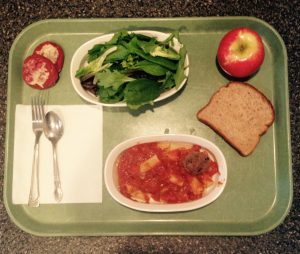When you visit your school lunchroom, are you aghast or impressed by what you see and hear? Most educators fear the cafeteria. It can be the most difficult time of the school day to manage. Should it be a time for students to unwind, socialize, and relax or is it a time to demand order and quiet?
Lunchrooms range from chaotic to silent – neither of the extremes is considered a healthy environment for the proper digestion of food. The task of feeding 300 to 1,000 students or more is daunting and scheduling is a nightmare. According to M. T. Conklin’s book Eating at school a summary of NFSMI research on time required by students to eat lunch, lunch time should be a place to relax.
The Journal of Child Nutrition and Management says that by taking time for students to choose various foods and sit with friends is important to the development of healthy eating behaviors. 
Students’ lunch times vary from 20 to 30 minutes. Most of the time is used for standing in line, selecting food, eating, and cleaning up. This is a relatively smooth process until school personnel interrupt the line. Line interruptions take up time and efficiency of getting students through the line to the tables so they can properly consume their meal. With school personnel breaking the flow, students spend a considerable amount of the time standing in line or waiting to get in a line for their lunch.
Today more students are eligible for free and reduced meals than before. This means the food line is getting longer. Inadequate time to eat discourages the purchase and consumption of healthy food. Students select snacks for quick ingestion, throw away healthy food, or skip eating altogether.
Students need time to relax in order to process the information from the morning lessons. The adults in the cafeteria are able to help with processing by interacting positively with students and allowing for social interaction and not chaos or silence. If too much pressure is placed on eating and finishing the meal, anxiety will occur.
Creating a pleasant climate in the cafeteria leads to better academic work and less behavior problems. Rules should be posted and reviewed and good behavior encouraged. Seating students at round tables rather than long rectangular tables are best for socialization and creates a cafe look to the room. Rectangular tables cause students to talk loudly across other children and create behavior problems from annoyances. They also cause overcrowding as students try to squeeze into a small space to sit near a friend.
A lack of time to eat is unhealthful and results in students being overweight or obese. Foods that are healthy take more time to eat (a salad will take more time to consume than French fries).
Creative solutions to the challenge of lunchroom demands are simple: add additional serving lines, stagger arrival time, add another entrance or exit, supply games or activities for students that finish eating. When possible, have students go to recess before lunch so they are hungry, ready to rest a bit, and converse while eating.
Help from parents will go a long way. School nutritionists can send fliers or put posts on the school website to encourage good eating habits at home. By modeling and taking time to socialize at the table with family will build a foundation for healthy eating habits at school.
With school meals under scrutiny to have healthy food served to students, one would think that the climate of the eating area also be healthy and free of stress producing loud noises and chaotic movement. There is no one solution. What works for one may not work for others. All in all, the lunch period is a time for social relaxation. School personnel must take time to evaluate procedures and make the eating area a pleasant time of the day.



